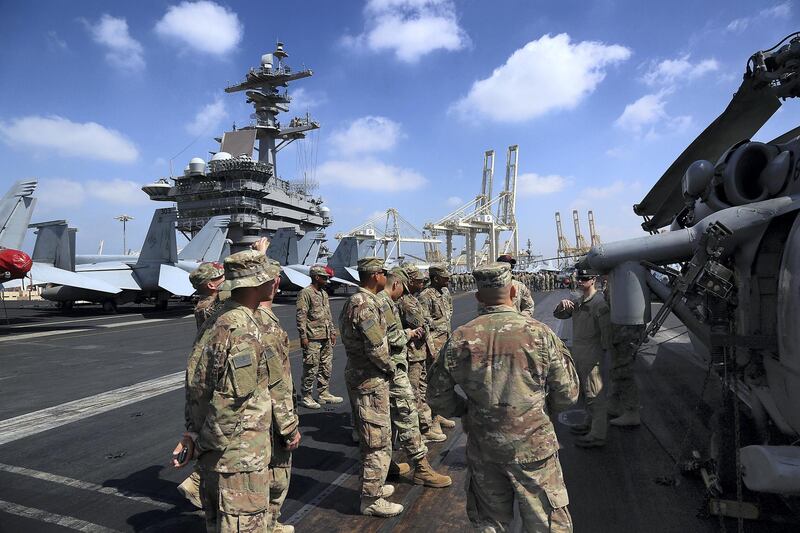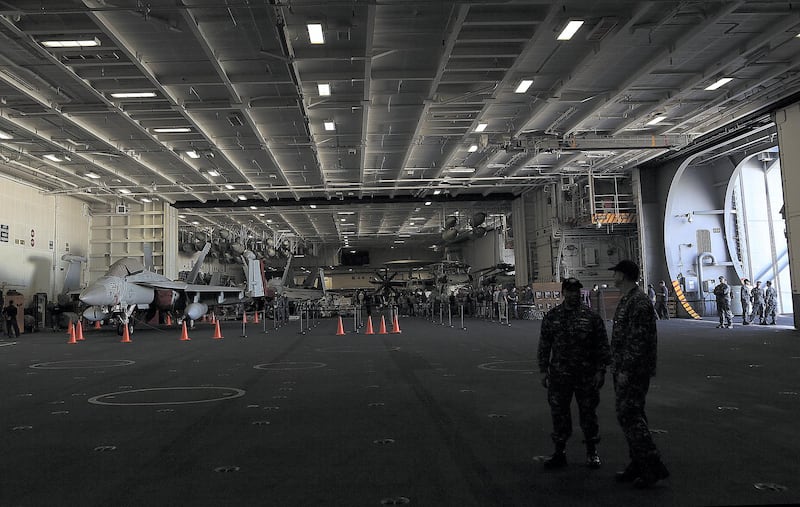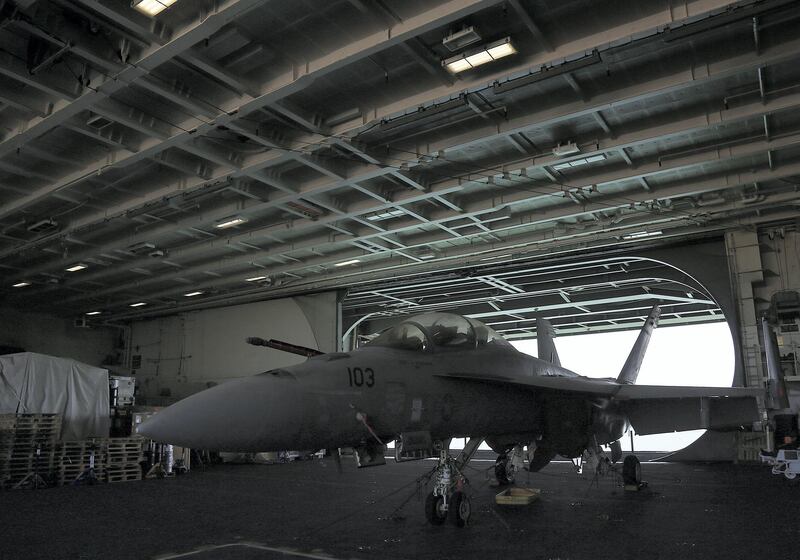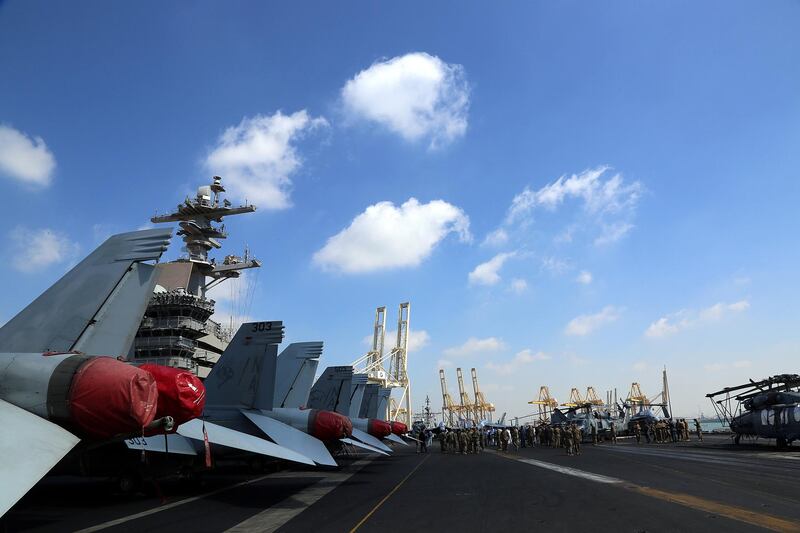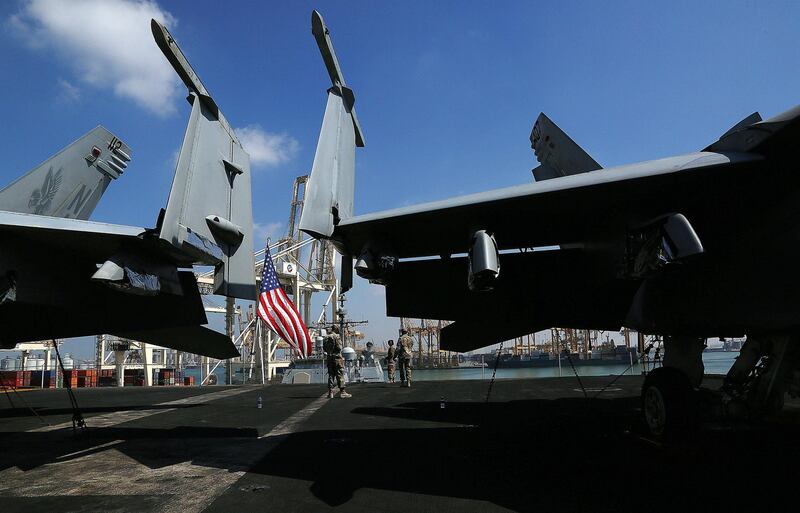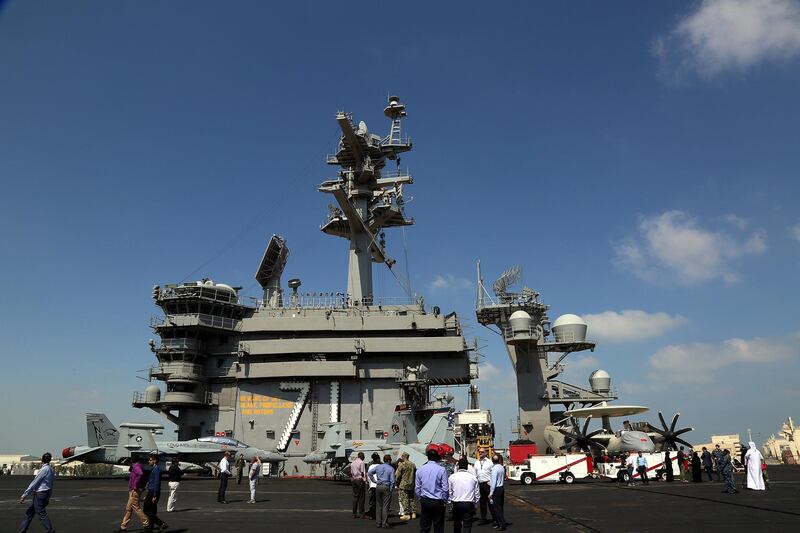The USS Theodore Roosevelt is known as the ‘Big Stick’ by many who serve on board the 332-metre aircraft carrier, and it’s easy to see why as it lies in Jebel Ali Port on a brief Dubai stopover.
Described as “an implement of power” and towering 20 storeys above the waterline, the ship is loaded with more than 70 fighter planes and helicopters primed and ready for conflict.
The giant vessel has been a menace patrolling the Arabian Gulf in support of anti-terror Operation Inherent Resolve.
Since departing from San Diego in October, the nuclear-powered Nimitz-class aircraft carrier has been leading operations in Syria and Iraq – targeting strongholds in the region in the war on ISIL.
It has been a long four months for the 5,000 crew who, along with a further 1,500 sailors and marines on board supporting vessels in the carrier strike group, are not due back in the US until later this year.
America’s ambassador to the UAE, Barbara Leaf, addressed the ship’s crew, before a short break in Dubai and the next stage of combat operations in the Arabian Gulf.
“Since departing from San Diego with USS cruiser Bunker Hill, destroyers USS Sampson, Preble and Halsey the USS Theodore Roosevelt has exemplified our country’s commitment to regional security and defence co-operation in the Middle East,” she said.
“These 7,500 sailors and marines represent the most capable maritime fighting force anywhere in the world today.
“Whether for military operations with our host partners, scheduled maintenance visits or rest and relaxation stops their presence is helping strengthen security relationships with the UAE.
“It has been a profound privilege to be part of this deepening defence and security relationship between our two countries.”
Since December 2014, the UAE has had 178 port visits from carriers, destroyers, cruisers, ships, submarines and other US ships.
In that time, 130,000 sailors and marines have gone ashore to experience the culture of the UAE.
Dubai is a regular stopping point due to its strategic location, wealth of supplies and attraction as a recovery destination for crew.
Life on board the USS Theodore Roosevelt, one of the largest ships in the US fleet, is a 24-hour operation for its crew, with the craft’s nuclear capability enabling it to remain at sea indefinitely.
Replenishment at sea is scheduled weekly with supplies jet fuel, food, repair parts and mail delivered by helicopter, cables and hoses.
“We have 5,000 people residing on this ship and it takes every single one of them to make things work,” said Rear Admiral Steve Koehler, who is Commander of Carrier Strike Group 9.
"It is an implement of power for the United States and gives us the ability to execute that power in security operations alongside all our friends and allies in the Gulf region."
______________
Read more:
British Royal Navy ships docked in Dubai offers insight into fight against terror and piracy
HMS Middleton prepares to leave dock at Ras al Khaimah
The deadly ISIL ambush in Kirkuk signifies the re-emergence of the terrorist group
__________________
The 31-year-old USS Theodore Roosevelt will return to America after completing its tour of Guam, Bahrain and the UAE.
Travelling the 40,200 kilometres through the Sea of Japan at more than 30 knots, the ship can be sent to the region from US waters in less than two weeks.
“We couldn’t come to the UAE without the great partnership we have in place with this great nation to help make this place a safe place in which to live and work,” said Commander Koehler.
“This is a 24-hour operation when we are at sea, so to be able to come into port for a few days and give the crew a break is phenomenal.”
Of the 70 aircraft on board, many can launch GPS guided smart bombs to take out their targets.
Although most of the ship’s major maintenance is completed when back in dock in San Diego, the crew can resolve most issues at sea.
Kitchens supply well-fed staff on board with 18,000 meals a day, but Dubai is timely stop for the crew, who have been at sea for most of the past three months.
“Operations against ISIL have been our main objective during our time here in the Arabian Gulf,” said executive officer Capt Fred Goldhammer
“Our aircraft are flying missions into Syria and Iraq in support of those operations against ISIL, that has been our main job out here.
“We use precision guided bombs; we are very specific with the targets selected for missions in counter ISIL operations to minimise risk to civilians or any other casualties.
“Our progress against ISIL in this region has been very successful, but this has not just been a US operation; we have been working with our partners in the region.”
The flight deck’s MH-60 helicopters are used for looking for other ships and submarines to gather intelligence, while the Hawkeye command and control aircraft delivers information back to the Carrier Air Wing to help plot a route and monitor operations.
Strike fighters such as the F18 can counter other aircraft and engage in combat, as well as take on air to ground combat operations.
Nuclear power runs the ship, while electromagnetic catapults help launch aircraft from the flight deck.
Rubber catapult tracks attach to a metal shuttle that connects to aircraft, to power them down the runway at 190mph in half a second like a slingshot.
Everything is overseen by runway ‘shooter’, monitoring four catapults simultaneously to deploy fighters as quickly as possible.
“When I started flying 20 years ago, to change an engine on a fighter would take a couple of days - now it takes one hour,” said Capt Goldhammer.
“The older versions of the helicopter also took a lot longer to repair, and it was more of an art than a science – a bit like having a classic car.”
